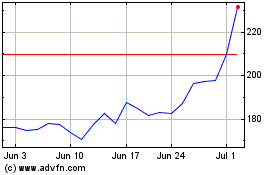Tesla Owners Will Have to Pay for Supercharger Access
June 01 2016 - 1:40PM
Dow Jones News
Tesla Motors Inc. will charge for the ability to use its network
of Supercharger equipment for buyers of the forthcoming Model 3, a
return to a practice the company once used on less expensive
versions of the Model S.
Chief Executive Elon Musk said Tuesday at Tesla's annual
shareholders' meeting the company would have to charge for use of
the fast-charging system to make the economics work. When Tesla
started selling the Model S sedan in 2012, buyers of the 60-kWh
battery pack and the 40-kWh battery pack had to pay $2,500 to
access the Superchargers. Those models were discontinued because of
low demand.
It is an important development for Tesla because the
fast-charging network, which Tesla valued at $166.6 million in
2015, is an important marketing feature for the company. It allows
customers to recharge the large battery on the car in under an
hour. A non-Tesla 240-volt charger commonly found in cities and
parking areas could take 10 hours.
A young shareholder, who said he took possession of a Model S
85D last July and put 150,000 miles on it in less than a year,
asked how the company would keep up with Supercharger demand with
the potential for hundreds of thousands of new cars to be sold. The
company has taken $1,000 deposits for nearly 400,000 Model 3
electric cars. Tesla plans on producing the new car, which starts
at $35,000, in the second half of 2017.
"The obvious thing to do is to decouple that (cost) from the
cost of the Model 3," Mr. Musk said. "It will still be very cheap,
especially in comparison to gasoline, but it will not be free long
distance for life unless you purchase that option."
Last year, Mr. Musk at the shareholder meeting made the first
hints that a change to the policy around the Superchargers might
come. He made reference to people "abusing" the system by using it
for daily charging rather than for quick fill ups between cities,
causing congestion at the stations. The statement set off intense
debates on Tesla's enthusiastic online message boards.
As the number of Teslas has grown beyond 100,000 globally, the
fast-charging stations, which now number 634, with 3,780 individual
chargers, have become crowded in some areas where the population of
cars is dense. Tesla has tried to offset this by building
"destination" chargers at hotels and parks that provide charging
that is faster than regular 240-volt chargers, but slower than the
Superchargers.
Write to Mike Ramsey at michael.ramsey@wsj.com
(END) Dow Jones Newswires
June 01, 2016 13:25 ET (17:25 GMT)
Copyright (c) 2016 Dow Jones & Company, Inc.
Tesla (NASDAQ:TSLA)
Historical Stock Chart
From Mar 2024 to Apr 2024

Tesla (NASDAQ:TSLA)
Historical Stock Chart
From Apr 2023 to Apr 2024
